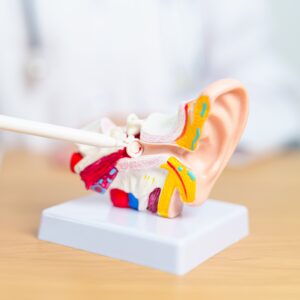Cerumen, commonly known as ear wax, plays a crucial role in the health and functioning of our ears. Despite its often negative perception, cerumen serves essential protective, cleaning and antibacterial functions in the ear canal. This blog post explores what cerumen is, why it’s important and what happens when it builds up or becomes impacted.
What is Cerumen?
Cerumen is a natural substanceproduced by glands in the outer ear canal. Its primary components include keratin, fatty acids, alcohols, cholesterol and squalene.
The composition of cerumen varies among individuals, influenced by genetics, diet, and environment. Typically, it exists in two forms: wet, which is sticky/yellow or brown, and dry, which is crumbly, grey or tan.
The Protective Role of Cerumen
The primary function of cerumen is to protect the ear by trapping dust, bacteria and other foreign particles, preventing them from reaching the sensitive eardrum. It also has pH-balancing and antimicrobial properties that help reduce the risk of infections in the ear canal.
As we move our jaws to chew or talk, old cerumen is naturally pushed out of the ear canal, carrying with it any trapped debris—a self-cleaning process that maintains ear health.
When Cerumen Becomes a Problem: Build-up and Impaction
While the production of cerumen is normal and healthy, problems arise when there is excessive production or insufficient clearance from the ear canal. This can lead to build-up or impaction, where cerumen hardens and blocks the ear canal.
Cerumen Build-up
Build-up generally occurs gradually and can often go unnoticed until symptoms start to appear. Common signs include a feeling of fullness in the ear, gradual hearing loss or ringing in the ears. Cerumen build-up is more common in older adults, individuals who use hearing aids and those who frequently use in-ear headphones.
Impacted Cerumen
Impaction refers to cerumen that has become so hard and thick that it completely blocks the ear canal. Symptoms of impacted cerumen include significant hearing loss, dizziness, earache and coughing. This condition requires professional intervention to safely remove the cerumen without damaging the ear.
Managing Cerumen Build-up and Impaction
It is important not to attempt to remove excessive or impacted cerumen with cotton swabs, hairpins, or other objects. Such attempts can push the wax further into the ear canal, worsening the impaction and potentially causing damage to the eardrum.
Professional Removal
Our Registered Nurses at Earworx, use safe and effective methods for cerumen removal. These include micro-suction, where a small vacuum is used to suck out the cerumen, and manual removal with specialised instruments under direct vision.
Home Care
For minor build-up, over-the-counter eardrops designed to soften cerumen can be helpful. If you have a hole in the ear drum or grommets, you should not use drops. These preparations can facilitate the natural expulsion of wax from the ear. However, individuals with a history of ear problems should consult a professional before using such products.
Prevention of Cerumen Problems
Preventing cerumen build-up and impaction involves understanding and managing your ear health. Avoid inserting objects into your ears, protect your ears from excessive dust and debris. For those prone to cerumen issues, regular check-ups with Earworx can help manage the situation before it becomes problematic.
Conclusion
Cerumen, or ear wax, is more than just a nuisance—it is a vital part of our ear’s defence system. Understanding its role and how to manage its build-up or impaction can help maintain ear health and may prevent hearing issues. For persistent or problematic cerumen, professional evaluation and treatment are advised to safely and effectively address the issue.
Find your nearest clinic and book an appointment today.


